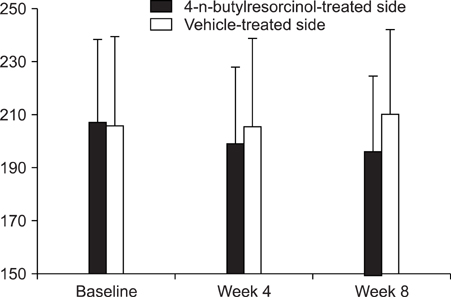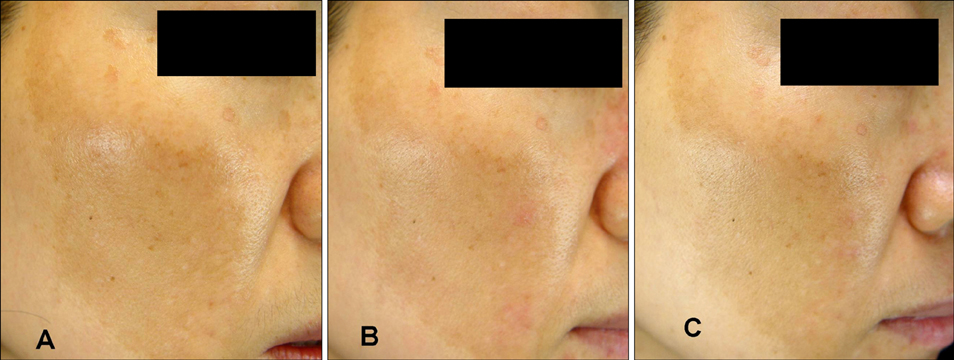Ann Dermatol.
2010 Feb;22(1):21-25. 10.5021/ad.2010.22.1.21.
The Efficacy and Safety of 4-n-butylresorcinol 0.1% Cream for the Treatment of Melasma: A Randomized Controlled Split-face Trial
- Affiliations
-
- 1Department of Dermatology, Seoul National University Bundang Hospital, Seongnam, Korea. gcpark@snu.ac.kr
- 2Department of Dermatology, Seoul National University College of Medicine, Seoul, Korea.
- KMID: 2172032
- DOI: http://doi.org/10.5021/ad.2010.22.1.21
Abstract
- BACKGROUND
Melasma is a common acquired symmetrical hypermelanosis that occurs on sun-exposed areas, and it is frequently observed among women. Various treatment modalities have been tried, but none are completely satisfactory. 4-n-butylresorcinol, which is a resorcinol derivative that has an inhibitory effect on both tyrosinase and tyrosinase-related protein-1, was introduced in 1995 and it has received increasing attention as a new hypopigmenting agent. However, the hypopigmenting effect of 4-n-butylresorcinol in human subjects has only been shown in a few studies.
OBJECTIVE
The aim of this study was to investigate the hypopigmenting efficacy and safety of 4-n-butylresorcinol 0.1% cream for the treatment of melasma.
METHODS
Twenty patients with melasma were enrolled to this randomized, double-blind, vehicle-controlled, split-face comparative study. The patients were instructed to apply 4-n-butylresorcinol 0.1% cream or vehicle to each side of the face twice daily for 8 weeks. Mexameter measurements were performed along with photography at baseline, 4 weeks and 8 weeks. Adverse events were observed and recorded throughout the study. RESULTS: All the patients completed the study. Mexameter measurements demonstrated that the melanin index of the treated side showed a significant decrease when compared with that of the vehicle-treated side after 4 weeks (p=0.006) and after 8 weeks (p<0.0005). All the adverse reactions were mild and transient.
CONCLUSION
4-n-butylresorcinol 0.1% cream showed rapid efficacy and it was well tolerated when used for the treatment of melasma.
MeSH Terms
Figure
Reference
-
1. Hearing VJ, Tsukamoto K. Enzymatic control of pigmentation in mammals. FASEB J. 1991. 5:2902–2909.
Article2. Kobayashi T, Urabe K, Winder A, Jimenez-Cervantes C, Imokawa G, Brewington T, et al. Tyrosinase related protein 1 (TRP1) functions as a DHICA oxidase in melanin biosynthesis. EMBO J. 1994. 13:5818–5825.
Article3. Okubo T, Oyohikawa M, Futaki K, Matsukami M, Fujii A. The inhibitory effects of 4-N-butyl-resorcinol on melanogenesis [abstract]. J Dermatol Sci. 1995. 10:88.4. Tasaka K, Kamei C, Nakano S, Takeuchi Y, Yamato M. Effects of certain resorcinol derivatives on the tyrosinase activity and the growth of melanoma cells. Methods Find Exp Clin Pharmacol. 1998. 20:99–109.
Article5. Katagtri T, Okubo T, Oyobikawa M, Futaki K, Shaku M, Kawai M. Novel melanogenic enzymes inhibitor for controlling hyperpigmentation. 1998. In : 20th IFSCC International Congress; 1–11.6. Shimizu K, Kondo R, Sakai K. Inhibition of tyrosinase by flavonoids, stilbenes and related 4-substituted resorcinols: structure-activity investigations. Planta Med. 2000. 66:11–15.
Article7. Kim DS, Kim SY, Park SH, Choi YG, Kwon SB, Kim MK, et al. Inhibitory effects of 4-n-butylresorcinol on tyrosinase activity and melanin synthesis. Biol Pharm Bull. 2005. 28:2216–2219.
Article8. Akasaka T, Ohurazaka H, Nishioheda G, Matsumoto S, Takenouchi M. Topically applied 0.3% 4-n-butylresorcinol decreases pigmentation after laser therapy. Environ Dermatol. 2002. 9:11–15.9. Researching committee of Rucinol(R). The study on the efficacy of Rucinol(R) (4-n-butylresorcinol) in chloasma. Nishinihon J Dermatol. 1999. 61:813–819.10. Khemis A, Kaiafa A, Queille-Roussel C, Duteil L, Ortonne JP. Evaluation of efficacy and safety of rucinol serum in patients with melasma: a randomized controlled trial. Br J Dermatol. 2007. 156:997–1004.
Article11. Cassano N, Alessandrini G, Mastrolonardo M, Vena GA. Peeling agents: toxicological and allergological aspects. J Eur Acad Dermatol Venereol. 1999. 13:14–23.
Article12. Long CC, Finlay AY. The finger-tip unit--a new practical measure. Clin Exp Dermatol. 1991. 16:444–447.
Article13. Clarys P, Alewaeters K, Lambrecht R, Barel AO. Skin color measurements: comparison between three instruments: the Chromameter(R), the DermaSpectrometer(R) and the Mexameter(R). Skin Res Technol. 2000. 6:230–238.
Article
- Full Text Links
- Actions
-
Cited
- CITED
-
- Close
- Share
- Similar articles
-
- A split-face study evaluating the efficacy of a topical antioxidant cream containing tocotrienol after 1064-nm picosecond Nd:YAG laser treatment for environment-induced skin pigmentation
- Efficacy of Topical Tranexamic Acid in Treatment of Melasma
- Change of Quality of Life after Melasma Treatment
- A split-face study to evaluate the efficacy of a dissolving microneedle-encapsulated niacinamide skin patch for the reduction of facial hyperpigmentation
- Split-face Comparison of Pulse-in-pulse Type Intense Pulsed Light Versus Low-fluence Multi-pass 1064 nm Q-switched Nd:YAG Laser in the Treatment of Facial Melasma





